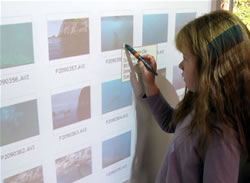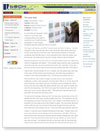The seal deal
 Class: New Entrant – Year 2
Class: New Entrant – Year 2
Teacher: Nikki Tapp
School: Huirangi Primary School
Category: Classroom unit
Duration: Six hours
As part of the unit 'Seaweek', Nikki's class of 5 – and 6-year-olds combined photos and videos to create their own PowerPoint-style presentation to teach people something about the seals that visit a local beach.
The Sugar Loaf Islands, just off the Taranaki coast, are home to kekeno – the New Zealand fur seal. Pups are often left on New Plymouth's Back Beach when their mothers head offshore to find them food. Well-meaning members of the public sometimes move the little seals, or even take them home. When the mother can't find her pup, she heads back to sea and a hungry orphan is left on the beach.
Nikki first showed the class two DVDs on Taranaki's marine reserves to capture the children's imagination and interest. "They thought marine reserves were a great idea especially when they saw kids snorkeling among the fish," said Nikki. "They saw a seal too and that was exciting because some had already seen them at the beach."
Callum Lilley, a Marine Ranger for DOC Taranaki, had shot photos and video clips of the seals, on their islands and under the sea, and made them available for classes to use in their presentation work. This proved an excellent resource.
Nikki showed the class Callum's images using the school's new interactive whiteboard, so they could choose the ones they liked. With an on-screen tap of the active board pen, the children took turns at opening Callum's images and videos. Some video clips were better than others and the class soon learnt to identify and open the most appealing. Their 'What looks good' list included the seal clips that were clear, close up and under the water. "They particularly liked the seal tricks," said Nikki, "the barrel rolls and sharp turns."
To build some knowledge, Nikki used the The Seal Deal, a publication on the DOC website that tells of the seals and the problems they face. The illustrations are big and appealing and ideal on the big screen. Each snippet of information linked to an illustration so it was quite easy for the children to grasp. The class learnt about the problem with the pups and also found that people thought that seals were sick when really they were resting in the sun. They found that dogs disturbed seals too.
Using a T chart, the class compared themselves to the seals. "Children retain a lot more when they link new knowledge back to themselves," said Nikki. "They now knew that the seals were good swimmers and the children thought they were quite good too. They knew that seals liked lying in the sun 'just like us, but we have to slip, slop and slap'." One student had been on the beach with her dog when they came across a seal and she told the class that her mum had tied the dog up. All these ideas became possibilities for a photo story.
"We made a list of things we would have in our photo story," said Nikki "and each group took one of these ideas and worked out what they would show and what they would say. They had to link an image or two with some words and if there was no image they had to work out what to photograph or draw."
The groups sketched their ideas on one or two big pieces of paper and, once everyone had explained their drawings to the class, they worked out the order of their photo story by holding up their sketch and moving into the right position along a line. Once the class had settled on an order, the storyboard was sketched on the whiteboard.
Photos were taken and pictures drawn and, along with Callum's photographs, they became the photo story images. The class used the program Photo Story – a friendly version of PowerPoint where text, images, commentary and music can be easily organised into a presentation – which was projected on to the whiteboard.
"Using the interactive whiteboard enabled the whole class to see and justify their choices together," said Nikki. "They chose and moved the photos and worked out the music and anyone not actually tapping the board was watching and learning."
The final photo story – Huirangi School's own Seal Deal – was played at a Grandparents Day at the school to illustrate the children's use of the new technology. It was also shown during Seaweek – after a public talk which Callum gave about Taranaki's marine reserves. It went down very well and reflected the children's enthusiastic response to what was a highly engaging subject and activity.


